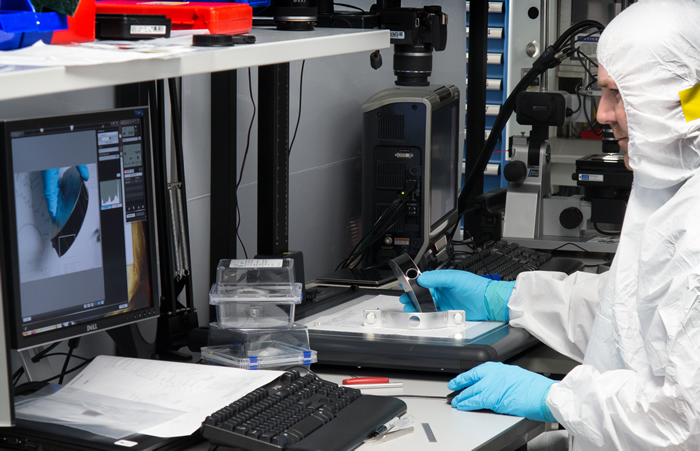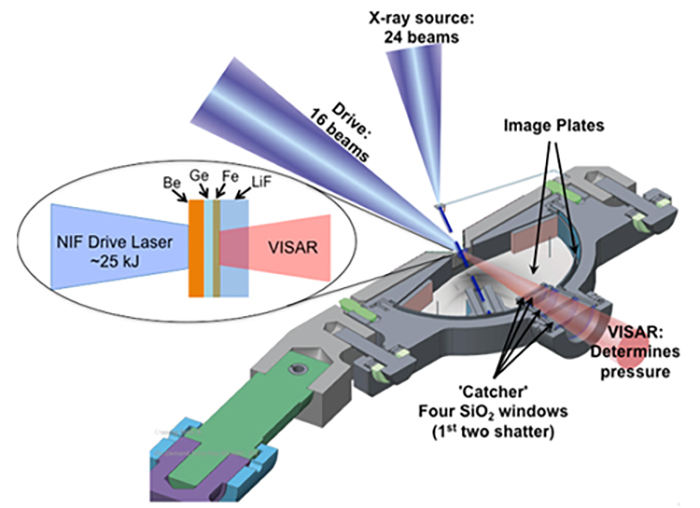NIF’s TARDIS Featured in Review of Scientific Instruments
June 3, 2020
A paper describing the design and performance of a workhorse NIF experimental platform known as TARDIS (target diffraction in situ) was a featured article in a recent edition of the journal Review of Scientific Instruments. The paper details the platform’s experimental setup, data processing, and uncertainty analysis.
 Diagnostics technician Bowdi Helgesen assembles a TARDIS x-ray diffraction diagnostic in the NIF diagnostics factory.
Diagnostics technician Bowdi Helgesen assembles a TARDIS x-ray diffraction diagnostic in the NIF diagnostics factory. TARDIS employs a technique known as x-ray diffraction, which determines the crystal structure of solids. Ramp-compressed samples are probed by diffraction of x rays generated by a laser-driven source foil. The resulting diffraction lines provide insights into phase changes, or structural transitions, that can occur in materials under extreme pressure (see “NIF’s TARDIS Aims to Conquer Time and Space”).
TARDIS, the first project to include a NIF target and diagnostic on a single, integrated platform, has measured x-ray diffraction to more than 20 megabars (20 million times Earth’s atmospheric pressure) to determine the crystal structure, measure the density, and evaluate the strain-induced texturing of a variety of compressed samples.
Used in NIF’s high energy density science and Discovery Science programs, the TARDIS experimental system provides important information on the characteristics of materials used in nuclear weapons as they age or are subjected to the immense pressures and temperatures of a thermonuclear explosion, as well as materials found in the center of stars and giant planets.
“X-ray diffraction is a technique that has been used for over a century for scientific discovery and characterization in materials science,” said the paper’s first author, Ryan Rygg, a former LLNL researcher now with the Laboratory for Laser Energetics (LLE) at the University of Rochester. “We are pleased to bring this capability to the National Ignition Facility, which allows us to bring this technique to the frontier of high-pressure science.”
Exotic Behaviors
At extreme pressures above one megabar, the paper’s authors said, “core electrons on neighboring atoms begin to interact, and matter has been observed to exhibit a variety of exotic behaviors. Examples include severe reduction in the melt temperature, superionicity (a strange liquid form of water ice), metals becoming transparent, and insulators becoming conductors.
“These dramatic changes in material properties under pressure have a number of practical consequences, including for the structure and evolution of astrophysical bodies and for various terrestrial applications such as inertial confinement fusion.”
Ramp-compression experiments on NIF apply a carefully tailored laser pulse shape that more “softly” compresses a material without forming a shock. NIF’s ability to tweak pulse-shaping keeps temperatures low enough to preserve the sample’s solid state.
“NIF allows us to control the energy of the beams as a function of time so we can compress the sample more slowly—keeping it solid,” explains Jon Eggert, LLNL group leader for Dynamic Materials Properties and a co-author of the Review of Scientific Instruments paper. “NIF is fantastic for ramp compression.”

In TARDIS experiments, up to six NIF quads (sets of four beamlines) drive a backlighter, which produces the x rays that impinge on the targets. The target consists of a sandwich of materials, including an ablator, a pre-heat shield, the material sample, and a window for the VISAR (velocity interferometer system for any reflector) diagnostic. The VISAR records the velocity of the dynamically compressed target—a measurement that can be used to determine the sample’s pressure.
Among the many NIF Discovery Science campaigns employing TARDIS, a research team is using the platform to study exotic phases of magnesium and sodium chloride (table salt), the surprising stability of the diamond phase of carbon, and the melting curve of iron at pressures ranging from 5 to 20 megabars. The research is important because Earth’s magnetosphere, which helps to protect life from the Sun’s solar wind, magnetic storms, and harmful cosmic rays, may be generated by the circulating molten iron in Earth’s core.
“Manuscripts describing new diffraction results on several materials compressed up to 2 TPa (20 megabars) are currently in preparation,” the researchers said. “Over the last century, x-ray diffraction has been an invaluable tool for probing and understanding materials, and we are pleased to push this capability toward the current frontier of high-pressure science.”
Joining Rygg and Eggert on the paper, “X-ray diffraction at the National Ignition Facility,” were LLNL colleagues Ray Smith, Amy Lazicki, Dave Braun, Dayne Fratanduono, Rick Kraus, James Mcnaney, Damian Swift, Christopher Wehrenberg, Federica Coppari, Maryum Fatima Ahmed, Maria Alejandra Barrios, Kerri Blobaum, Angela Cook, Pascale Di Nicola, Beth Dzenitis, Sally Gonzales, Brian Heidl, Matthias Hohenberger, Allen House, Nobuhiko Izumi, Dan Kalantar, Shahab Firasat Khan, Tom Kohut, Chockalingam Kumar, Nathan Masters, C.A. Smith, Ryan Vignes, Jonathan Ward, Mark Wall, Thomas Zobrist, and Tom Arsenlis along with Rip Collins, Danae Polsin, and Sean Regan of LLE and Justin Wark of the University of Oxford.
More Information
“Searching for an Exotic Phase of Magnesium,” NIF & Photon Science News, March 2018
“Probing the Possibility of Life on ‘Super-Earths,’” NIF & Photon Science News, May 2017
—Charlie Osolin
Follow us on Twitter: @lasers_llnl



